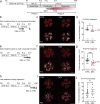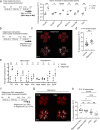Timed topical dexamethasone eye drops improve mitochondrial function to prevent severe retinopathy of prematurity
- PMID: 39287727
- PMCID: PMC11564262
- DOI: 10.1007/s10456-024-09948-2
Timed topical dexamethasone eye drops improve mitochondrial function to prevent severe retinopathy of prematurity
Abstract
Pathological neovascularization in retinopathy of prematurity (ROP) can cause visual impairment in preterm infants. Current ROP treatments which are not preventative and only address late neovascular ROP, are costly and can lead to severe complications. We showed that topical 0.1% dexamethasone eye drops administered prior to peak neovessel formation prevented neovascularization in five extremely preterm infants at high risk for ROP and suppressed neovascularization by 30% in mouse oxygen-induced retinopathy (OIR) modeling ROP. In contrast, in OIR, topical dexamethasone treatment before any neovessel formation had limited efficacy in preventing later neovascularization, while treatment after peak neovessel formation had a non-statistically significant trend to exacerbating disease. Optimally timed topical dexamethasone suppression of neovascularization in OIR was associated with increased retinal mitochondrial gene expression and decreased inflammatory marker expression, predominantly found in immune cells. Blocking mitochondrial ATP synthetase reversed the inhibitory effect of dexamethasone on neovascularization in OIR. This study provides new insights into topical steroid effects in retinal neovascularization and into mitochondrial function in phase II ROP, and suggests a simple clinical approach to prevent severe ROP.
Keywords: Dexamethasone; Eye drops; Mitochondrial function; Neovascularization; Oxygen-induced retinopathy; Retinopathy of prematurity.
© 2024. The Author(s).
Conflict of interest statement
Figures





Update of
-
Timed topical dexamethasone eye drops improve mitochondrial function to prevent severe retinopathy of prematurity.Res Sq [Preprint]. 2024 Jun 25:rs.3.rs-4619093. doi: 10.21203/rs.3.rs-4619093/v1. Res Sq. 2024. Update in: Angiogenesis. 2024 Nov;27(4):903-917. doi: 10.1007/s10456-024-09948-2. PMID: 38978601 Free PMC article. Updated. Preprint.
References
-
- Sato T, Wada K, Arahori H, Kuno N, Imoto K, Iwahashi-Shima C, Kusaka S (2012) Serum concentrations of bevacizumab (avastin) and vascular endothelial growth factor in infants with retinopathy of prematurity. Am J Ophthalmol 153(2):327–333e321. 10.1016/j.ajo.2011.07.005 - PubMed
-
- Zehden JA, Mortensen XM, Reddy A, Zhang AY (2022) Systemic and ocular adverse events with Intravitreal Anti-VEGF therapy used in the treatment of Diabetic Retinopathy: a review. Curr Diab Rep 22(10):525–536. 10.1007/s11892-022-01491-y - PubMed
-
- Yossuck P, Yan Y, Tadesse M, Higgins RD (2000) Dexamethasone and critical effect of timing on retinopathy. Invest Ophthalmol Vis Sci 41(10):3095–3099 - PubMed
MeSH terms
Substances
Grants and funding
- ALFGBG-717971/Government grants under the ALF agreement
- R01 EY017017/EY/NEI NIH HHS/United States
- R01 HL126901/HL/NHLBI NIH HHS/United States
- P50 HD105351/HD/NICHD NIH HHS/United States
- R01EY017017/NH/NIH HHS/United States
- R01 HL149302/HL/NHLBI NIH HHS/United States
- R01HL126901/NH/NIH HHS/United States
- U54 HD090255/HD/NICHD NIH HHS/United States
- R01 EY030904/EY/NEI NIH HHS/United States
- R01 EY032492/EY/NEI NIH HHS/United States
- OFD/BTREC/CTREC Faculty Career Development Grant 97906/Boston Children's Hospital
- DNR# #2020-01092/Svenska Forskningsrådet Formas
- IDDRC (1U54HD090255)/Boston Children's Hospital
LinkOut - more resources
Full Text Sources

